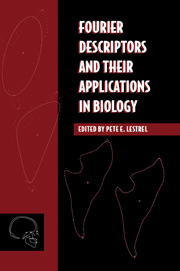Book contents
- Frontmatter
- Contents
- List of contributors
- Preface
- Acknowledgments
- Part one Theoretical considerations
- Part two Applications of Fourier descriptors
- 6 Closed-form Fourier analysis: A procedure for extraction of ecological information about foraminiferal test morphology
- 7 Fourier descriptors and shape differences: Studies on the upper vertebral column of the mouse
- 8 Application of the Fourier method on genetic studies of dentofacial morphology
- 9 Fourier analysis of size and shape changes in the Japanese skull
- 10 Craniofacial variability in the hominoidea
- 11 Heuristic adequacy of Fourier descriptors: Methodologic aspects and applications in Morphological
- 12 Analyzing human gait with Fourier descriptors
- 13 Elliptic Fourier descriptors of cell and nuclear shapes
- 14 Cranial base changes in shunt-treated hydrocephalics: Fourier descriptors
- 15 A numerical and visual approach for measuring the effects of functional appliance therapy: Fourier descriptors
- 16 Size and shape of the rabbit orbit: 3-D Fourier descriptors
- 17 From optical to computational Fourier transforms: The natural history of an investigation of the cancellous structure of bone
- 18 Epilogue: Fourier methods and shape analysis
- Appendix
- Glossary
- Index
17 - From optical to computational Fourier transforms: The natural history of an investigation of the cancellous structure of bone
Published online by Cambridge University Press: 14 September 2009
- Frontmatter
- Contents
- List of contributors
- Preface
- Acknowledgments
- Part one Theoretical considerations
- Part two Applications of Fourier descriptors
- 6 Closed-form Fourier analysis: A procedure for extraction of ecological information about foraminiferal test morphology
- 7 Fourier descriptors and shape differences: Studies on the upper vertebral column of the mouse
- 8 Application of the Fourier method on genetic studies of dentofacial morphology
- 9 Fourier analysis of size and shape changes in the Japanese skull
- 10 Craniofacial variability in the hominoidea
- 11 Heuristic adequacy of Fourier descriptors: Methodologic aspects and applications in Morphological
- 12 Analyzing human gait with Fourier descriptors
- 13 Elliptic Fourier descriptors of cell and nuclear shapes
- 14 Cranial base changes in shunt-treated hydrocephalics: Fourier descriptors
- 15 A numerical and visual approach for measuring the effects of functional appliance therapy: Fourier descriptors
- 16 Size and shape of the rabbit orbit: 3-D Fourier descriptors
- 17 From optical to computational Fourier transforms: The natural history of an investigation of the cancellous structure of bone
- 18 Epilogue: Fourier methods and shape analysis
- Appendix
- Glossary
- Index
Summary
Introduction
The remarkable patterns exhibited by cancellous bone, and the likelihood that it is related to mechanical stress and strain, have been known for a long time (e.g., Todd and Bowman, 1845; Wyman, 1867; Wolff, 1892). During most of that period, however, the nature of the cancellous patterns themselves remained based upon visual impressions of bone sections and later, bone radiographs (e.g., Thompson, 1917; Murray, 1936; Evans, 1957). It was not until after the middle of the present century that the idea of characterizing these complex bony patterns with Fourier analyses came about.
In 1968, J. C. Davis showed me how useful optical Fourier transforms could be in the analysis of thin sections of rocks (Davis, 1970). In so doing he put into my mind the idea that the method might be excellent for the study of sectional and radiographic information in bones. Using his specialized equipment, we produced the first transforms of cancellous architecture in sections of human vertebrae (Oxnard, 1970a; 1970b; 1972a; 1972b; 1973). The 1973 volume may have been the first time that a Fourier transform was figured on the cover of a book.
Later H. C. Pincus (e.g., Power and Pincus, 1974) demonstrated to me the Rank Image Analyser 2,000 used for similar purposes.
Information
- Type
- Chapter
- Information
- Fourier Descriptors and their Applications in Biology , pp. 379 - 408Publisher: Cambridge University PressPrint publication year: 1997
Accessibility standard: Unknown
Why this information is here
This section outlines the accessibility features of this content - including support for screen readers, full keyboard navigation and high-contrast display options. This may not be relevant for you.Accessibility Information
- 6
- Cited by
